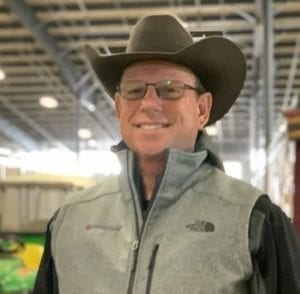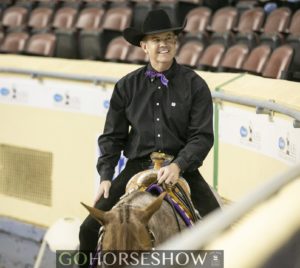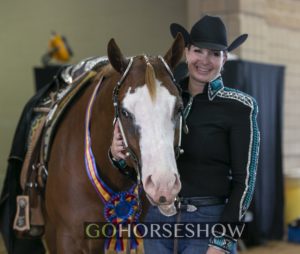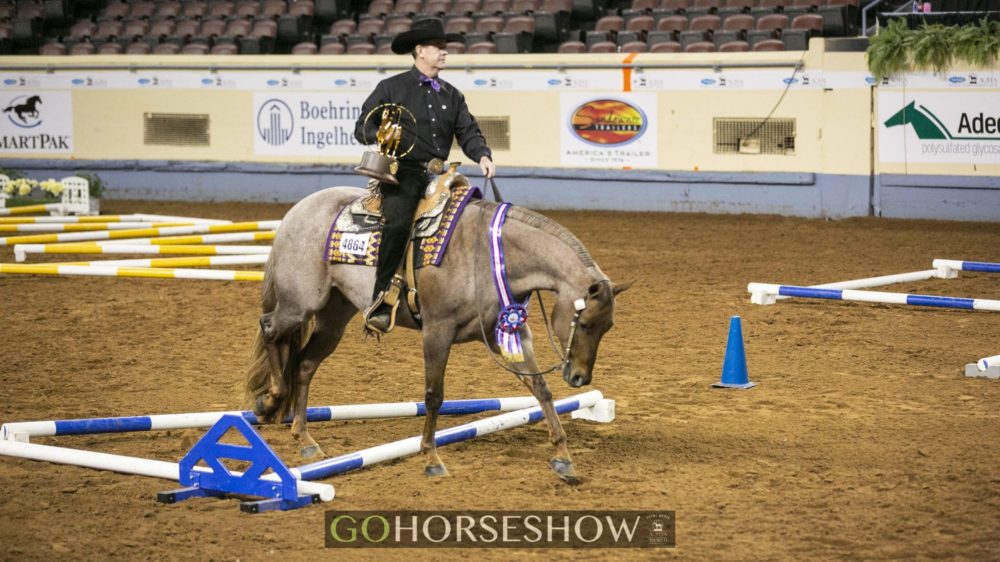Much emphasis is placed on working on and perfecting the “complicated moves” in a pattern: the lead change, the lope/trot over logs, or the patterns with tons of speed changes. However, the skills that earn the most plusses or minuses on a judge’s card are often thought to be more “basic” in nature.
We spoke with the experts to get their take on perfecting the fundamental movements that are frequently overlooked in a pattern. In this three-part series, we get advice from Leonard Berryhill, John Briggs, and Sara Simons on making the (1) stop, (2) back, and (3) side pass consistent point-earning opportunities.
Today’s article addresses the stop – whether stopping in a trail box, on the rail, or at a cone, a correct stop is potentially the most overlooked and underperformed pattern element.
Leonard Berryhill (The Scoring Approach):
 To ensure that you are practicing and performing a stop to make it a point-scoring opportunity, it is important to understand what makes a stop “correct.”
To ensure that you are practicing and performing a stop to make it a point-scoring opportunity, it is important to understand what makes a stop “correct.”
Berryhill walked us through what he looks for as a judge when scoring the stop in a pattern. He agrees that this is a frequently overlooked maneuver chuckling, “There is not a lot to this maneuver, but there is a lot that can go wrong.” He adds that “A great stop won’t win you a championship, but a bad one could certainly lose you one.”
Specifically, the stop does not give the same opportunity for scoring positive points as other, more complicated pattern elements. Still, Berryhill admits that he gives out minuses more than pluses for this seemingly simple maneuver.
A credit-earning stop to Berryhill is where the rider doesn’t need to do much to change their body position for a nice, soft, square stop. Instead, he likes to see a rider use a little leg, a gentle hand lift, and a soft “whoa” to communicate with their mount.
Berryhill wants the horse to respond to the rider’s cues by stopping square while keeping their body position – he doesn’t want to see them hollow their back, raise their neck, or open their mouth to avoid increased contact.
Instead, he looks for the horse to stop soft in the poll and body, which will be easier for the rider to sit, without looking uncomfortable. He believes using the word “whoa” allows the horse to prepare its body to stop and control its response.
Berryhill is a fan of light contact throughout a pattern and encourages light contact during the stop – particularly in horsemanship. Judges aren’t supposed to credit horses that go around on a completely draped rein for the horsemanship. Instead, he says he likes to see a horse “in the bridle without being over-bridled.”
While trail encourages a drape, he still wants to see some contact for the stop as it demonstrates a level of control for the rider and communication for the horse and rider as a team.
Berryhill admits that he is not a fan of the spur stop in any pattern. Specifically, he believes a spur stop (not to be confused with a stop involving leg pressure) results in the horse coming to a more jarring halt that looks rigid for the animal and uncomfortable for the rider.
Berryhill finds the stop to function as a “tattle” on a horse and rider team that isn’t in sync as it will often show a strong connection between the two…or lack thereof. He suggests that the best way to set up a good stop is to mentally, visually, and physically prepare for the stop. Before you come to the point you are to stop, use all your aids to communicate with your horse to come to a soft, controlled, collected halt. Once the horse has stopped moving, allow a clean pause before moving on to the next element of your pattern.
John Briggs (The Foundational Approach):
 Briggs is a firm believer that horses are creatures of habit, and so it is critical to establish a proper stopping habit to ensure that your mount stops correctly in a pattern. Briggs says he has a three-step training method for teaching horses to stop correctly.
Briggs is a firm believer that horses are creatures of habit, and so it is critical to establish a proper stopping habit to ensure that your mount stops correctly in a pattern. Briggs says he has a three-step training method for teaching horses to stop correctly.
The first way that he teaches his horses to stop is with old-fashioned “mouth brakes.” Briggs reminds us that this does not mean “yanking” a horse into a stop. Instead, he says horses tend to be most responsive to firm pressure on the mouth initially. He continues this process until the horse consistently stops moving their feet and halts where they are at with mouth pressure alone.
Once the hand stop is consistent, Briggs will move on to phase two of stopping: the verbal command. In this step, Briggs will say, “Whoa!” to get the horse to stop moving their feet. If the horse does not respond to the verbal command, he will go to his hand and then back them up a few steps to reinforce that “whoa means whoa.”
Once the verbal stop is consistent, Briggs will move to his final stop phase: the squeeze stop. The squeeze stop involves squeezing equally with the calves (not necessarily the spurs) in the center of the horse’s belly to get an immediate stop. Again, Briggs will continue asking for a squeeze stop until the horse is consistently responsive to the request at all three gaits.
Briggs will let the horse make the mistake of not listening in any of the latter two phases and then go to his hand as reinforcement throughout the process. Briggs sees the hand stop as the firmest command and therefore likes to use it as a backup for the verbal and squeeze commands.
Once he has completed all three phases with a horse, he puts them together for “a pretty good stop” in which he will lift his hand, squeeze his calves, and say, “Whoa!”
According to Briggs, “the more you repeat something consistently, the more [the horses] figures it out. So I want them stopping from all three gears as soon as I ask, regardless of where they are in the arena.” He reminds us that a firm, clean stop is important in rail classes too, and advises that you practice stopping all over the arena – at cones, on the rail, in trail boxes, etc.
Briggs suggests that, once your stop is good at home, it takes time to get a quality stop at a show where the horses are inevitably more distracted. He says to make sure to practice clean, responsive stopping in the warm-up arena and during classes so that your horse understands your expectations are consistent when asking for a stop.
Sara Simons (The Body Control Approach):
 According to Simons, the best way to guarantee a clean stop is to set your horse up properly to perform the maneuver physically. To stop correctly, “a horse must put their weight in their hind end and stop moving their back feet.”
According to Simons, the best way to guarantee a clean stop is to set your horse up properly to perform the maneuver physically. To stop correctly, “a horse must put their weight in their hind end and stop moving their back feet.”
Simons says she teaches a horse to stop from the hind end by stopping them and immediately pushing them into a back. She says the horse must put their weight in their haunches to back and, by linking the two maneuvers, you teach them that a stop should come from behind. Once the horse is stopping with its hindquarters, she will stop asking for an immediate back each time and let the horse settle and stand square.
One of the most common mistakes Simons sees at the stop is that the horse stops on its front end. The best way to avoid this is by making sure the horse is moving in a collected manner with its weight in the hindquarters before asking for a stop.
Specifically, a horse should be moving balanced and collected before stopping. Rhythm and cadence are critical to approaching a stop to ensure that your horse can perform the maneuver properly. Simons says that a collected horse should be traveling with its back up and carrying its neck level. She advises that you have them moving into the bridle while approaching the stop.
Sara recommends saying “whoa” when their hind feet are on the ground for the more advanced riders who can feel their horse’s footfalls. However, if you give the verbal command while their front feet are on the ground, it is far more likely the horse will “dribble step out of the stop before finally halting.”
Simons reminds us that the rider’s position is critical to performing a correct, clean stop. It is important to be centered in your saddle. If you are not centered, you will throw off your horse’s balance, which will make it harder to have a clean stop. She advises you to find the center of your horse’s balance so you are an aid to a correct stop and not a hindrance.
***
The goal of any pattern element is to complete it correctly with light contact. And, all of our experts agree, the best way to ensure both of these goals are met is by consistent, correct practice at home and shows.
Stay tuned for parts 2 and 3 of our Perfecting the Pattern series when we will talk to the experts about the back and the side pass.









